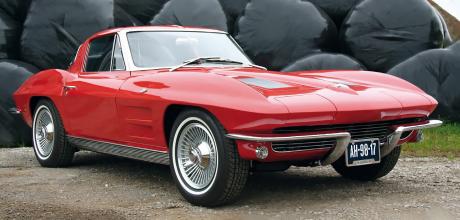1963 Chevrolet Corvette Sting Ray C2
No short cuts. No quick fixes. The painstaking, zero timed, concours condition restoration of John G Van Meewuen’s 1963 Corvette Sting Ray to its original Riverside Red glory is something to behold and all because of the remarkable attention to detail.
Words and photography: Paul Bussey
BETTER THEN NEW
When Dutch Corvette enthusiast John G Van Meewuen hankered after owning one of the most distinctive of all the mid-year Corvettes, the 1963 rear split-screen coupe, he decided to contact Alan Faulkner-Stevens at Dragon Wheels (www. dragonwheelsrestorations.co.uk) to see if he could source him a suitable car. John had already got to know Alan quite well as he had previously restored his 1962 Corvette, and it wasn’t long before the right car came along. Purchasing a car with some provenance is always more desirable than something completely unknown, and a friend of Alan’s was selling his car which he imported into the UK with history from the US many years ago.
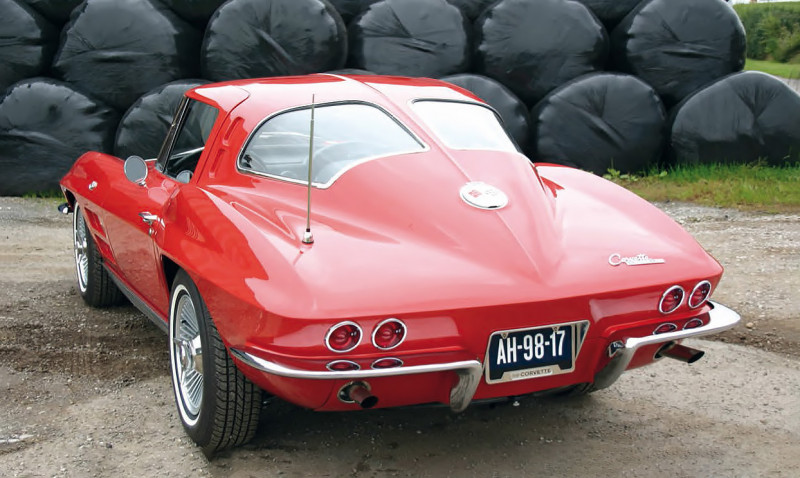
Built in November 1962, this particular car was one of the earliest split-screen coupes to roll off the production line and had the most powerful non-fuel injected engine available at the time: an L76 rated 340bhp which was mated to a four-speed aluminium cased Borg Warner T10 manual transmission, with a 4.11 differential and options including power steering and power brakes. John decided to purchase the 1963 Corvette Sting Ray coupe and enjoyed driving it around his native Holland for 18 months before delivering it to Alan’s workshop in rural Buckinghamshire where it underwent a total restoration. The coupe was originally painted Riverside Red, though it had been resprayed black in the Seventies and had also been fitted with side pipes.
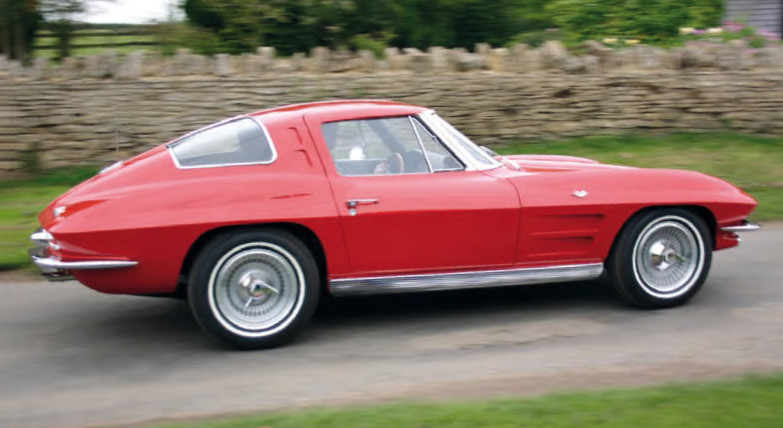
A full Dragon Wheels restoration involves removing the body from the chassis, dismantling all chassis components, taking the body to a bare shell and then rebuilding from the ground up. In effect, the finished car will be virtually a brandnew, ‘zero timed’ 1963 Corvette, personally built to concours standard, effectively even better than when it left the factory new. The kind of attention to detail is quite remarkable, as you will discover further into the restoration, as Alan doesn’t believe in short cuts or quick fixes. Nothing is left to chance, or overlooked, including every single component right down to the last bearing and bush. Therefore, the time scale of this type of restoration is in the region of two years – well, at least John G Van Meewuen still had his 1962 to drive while he waited for the ’63 coupe.
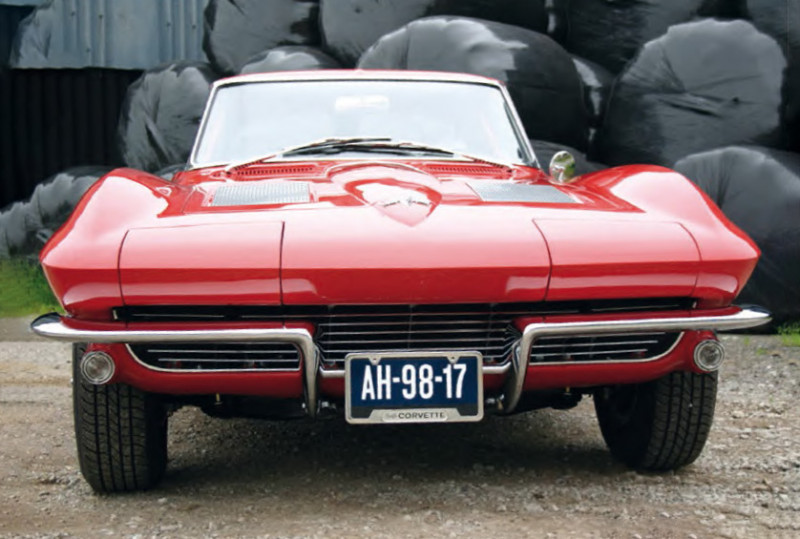
Once the chassis had been shot blasted back to bare metal, it was then powder coated black, along with every other metal component with a black finish. Even metal that you cannot see, such as inside the doors, the substructure behind the dashboard, the foot pedals and box assembly have all been powder coated. I asked Alan if going to these extremes of powder coating everything was normal practice? “It is on my restorations,” he asserted. “All metal components are shot blasted, zinc chromate etched and then powder coated for longevity. I entrust A&M Powder Coaters at Olney, Bucks (Tel. 01234 711605) with this process and their quality of workmanship is first rate.
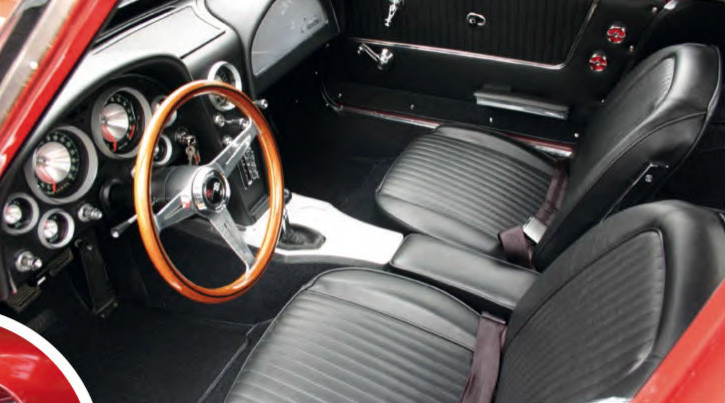
“The cost of shot blasting and powder coating a Corvette during restoration is in the region of £2000-£3000. Components, like the propshaft, drive shafts and front suspension uprights, left the factory in a bare metal finish, but I have them shot blasted, zinc chromate etched, powder coat them black, and finally spray them with a paint to look like the original finish so they look correct.
“At some time in its life, this ’63 coupe was slid into a kerb with both passenger-side wheels heavily impacting. The lower A-arm on the front suspension mounting bracket had broken and been poorly repaired which is a dead giveaway of Corvettes that have been damaged at the front. John had always complained that his car would steer into a corner much better one way than the other. When we lifted the body we found that the passenger rear suspension trailing arm was actually bent.

It had been adjusted as much as possible with the toe-in shims, but still toed out to a certain degree, despite all the shims. The front suspension mount was removed and repositioned. The impact had also cracked some of the other welds around the front of the car which were duly rewelded.”
After shot blasting the chassis, it blew up several small holes in the very back plates of the outer chassis rails. New sections were made up to match the originals and were put in with exactly the same gaps and lengths of weld as they would have been at the factory so you wouldn’t be able to notice any difference following the repair. Then, the original factory chassis, shim markings and stencilling were all applied and the whole of the drive train was rebuilt. This included the front and rear suspension, steering, brakes and chassis sports stainless steel brake and fuel lines. Absolutely everything was rebuilt and correctly detailed and date-coded.
The engine L76 has been totally rebuilt with all new, uprated internal components, including aluminium cylinder heads. While it’s still rated at around 340bhp, it’s monstrously strong inside and has much more torque: 370lb-ft in fact and will happily rev up to around 6500rpm. Alan entrusts all his engine rebuild work to Peter Knight of Knight Racing Services (www.knightracingservices.co.uk) at Daventry, Northants, and between them they have designed their own special specification for all ‘street engine’ rebuilds. The engine returns to Alan’s workshop for him to fully detail with a full dyno tune sheet so the customer knows exactly the power output and torque of their new engine. The transmission was also fully rebuilt with new shift rods. A Hurst shifter was fitted, but the stock lever has been retained, so it looks original. In order for the car’s driveability to be honed for maximum pleasure to match the performance of the engine rebuild upgrade, the rear axle has been fitted with 3.36:1 gearing.
With the fully rebuilt rolling chassis now completed, paradoxically, it seems almost a shame to cover it up again with the body, as so much painstaking work and detailing will never be seen, apart from the engine bay that is. Alan now focused his attention on the coupe’s bodywork and internal fixtures and fittings. The body was stripped of all its paint and gelcoat and then re-gelcoated and repainted in the original colour of Riverside Red using two-pack paint for longevity.
Originally the underside of the GFRP shell would have been left bare, but John wanted an easy-clean finish, so it was painted black. Although the front screen was in perfect condition, it was tinted, and as the early 1963 coupes didn’t originally have a tint, it was replaced with a new screen specially made in the US. Both door glasses were also replaced due to them being chipped. The seat frames were repaired where necessary, shot blasted, zinc chromate etched, powder coated, and then fitted with new foam and vinyl covers. In fact, all the soft trim in the interior was replaced.
Attention to detail went as far as sending all the instruments back to a specialist in the US to be restored as necessary. A very expensive replacement item which made John wince a little when he found out the cost was an original pair of seat belts, unique to the first 5000 Corvettes built in 1963. They had to be sourced, sent to a specialist in the States to be restored and then shipped back to the UK. The cost was £850 for the pair! “In most cases, it’s not the cost of restoring parts like these that’s so expensive, it’s buying the original parts in the States and fitting them,” Alan points out. “Other parts that were missing included the original horns which had to be sourced.
“There’s only one guy that I know and trust to do a good job when it comes to restoring Corvette instruments and he also refurbishes my headlamp motors. Then there’s another guy that specialises in Corvette carburettor rebuilds. I wouldn’t have these jobs done any other way and owners expect it to be done exactly right.” Naturally the coupe’s wiring loom has been renewed and the front indicators have been converted to comply with Dutch road laws. Alan has devised his own conversion which replaces the standard front indicators and sidelights which were orange. The original sidelight body is retained, but specially manufactured chromed retaining rings and clear lenses are fitted using a set of longer retaining screws. This conversion is popular with many of Alan’s other overseas customers. One departure from original has been to fit a Nardi wooden rim steering wheel which John finds more comfortable due to him being a strapping 6ft 2in tall Dutchman.
The standard 1963-1964 Corvette knock-off alloy wheels would normally have a cast finish, but they can easily discolour if the car is regularly used. In order to make them easier to clean, Alan has had them powder coated and the faces machined to leave a shiny finish and then they have been lacquered.
The coupe’s original brightwork has all been restored with the bumpers rechromed and aluminium trim needing extensive polishing to make perfect. New items on the body have included door handles and badging. John opted to go for a chambered exhaust system to be fitted, which makes his car sound louder than normal. In this Riverside Red stunner, another ‘63 split-screen model has been reborn, representing one of the finest around – and with its beauty being much more than skin deep, because it goes right to the very core!
Below: L76 V8 motor is good for 340bhp/370lb-ft torque. Right: GM tried to sprinkle some of the ’Vette’s fairy dust on the Corvair. Handsome profile would give the E-type a run for its money. Above: One-year-only split rear screen. Right: Clever marketing by Chevrolet. Corvette is handsome in Riverside Red paint.
’Vette wears Dutch plates. Inside: Nardi wooden rim steering-wheel – seatbelts were £850 a pair! Radio is vertical.


